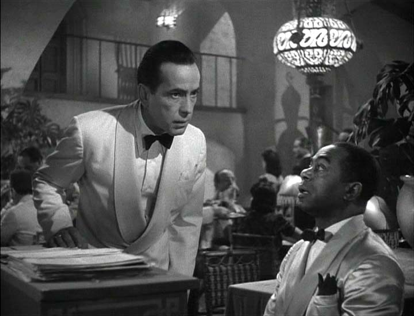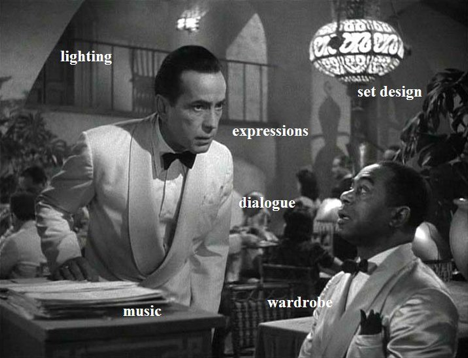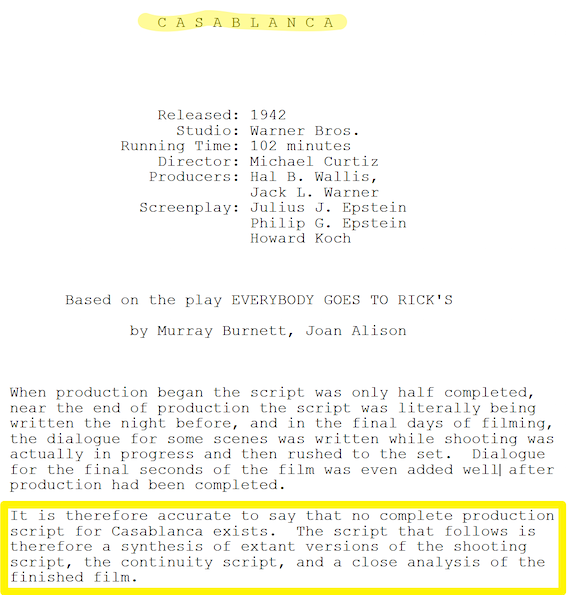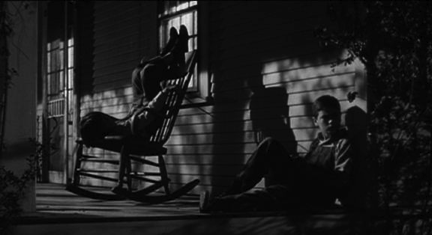Teaching Film Literacy Without the Film

Earlier this month, film & media literacy consultant Frank Baker led an all-day workshop for teachers in Los Angeles USD, in collaboration with the Academy of Motion Picture Arts and Sciences (the Oscars).
by Frank W. Baker
Why would an educator teach film without the film? Obviously, having the DVD (or VHS) of a title would be preferred. But what happens when one needs to teach a specific title without physically having the film?
I have previously written about the importance of film literacy, and the new Common Core ELA standards include specific references to film in both seventh and eighth grades.
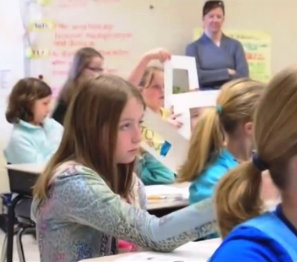
Many educators don’t have access to the software (or hardware) they need to teach film. But as I am going to explore, that should not be an obstacle.
Film Stills & Close Readings
The late film critic Roger Ebert, writing in his classic essay “How to Read a Movie,” noted that when he first began teaching film, he didn’t use the actual movie, but rather used film stills. Today, we might refer to these as “publicity stills”–the photos that film studios release for marketing purposes.
Ebert advocated then for what he called “frame analysis.” I would call this “visual literacy” and “close reading” because we want students to become more aware of what is happening inside the frame. (In film studies, this is referred to as “mise-en-scene,” a phrase that originated in theatre, which when roughly translated means everything that is happening on the stage.)
Here is an example: a film still from the classic 1942 movie “Casablanca.”
With little or no film education, most of us would not be aware of everything that is happening on screen. But by teaching “frame analysis” or helping students better comprehend the “language of film,” we can help them gain some sense of how to “read” the film and understand the ways in which a director communicates meaning using various techniques.
Because I have devoted some time to understanding how filmmakers communicate, when I experience Casablanca, here is what I see:
So using a film still—and having students look deeply at the image–is one strategy you could employ even if you don’t have the physical film.
Writing & Storyboarding
Do your students know that most films start out as a script or screenplay? Before one inch of footage is ever shot, the script is used by the director, the cinematographer and everyone else on the set as their guide. So the written word IS the bible. I previously wrote about the importance of teaching students the processes of both writing and storyboarding.
Have your students ever seen an authentic motion picture “screenplay”? If not, there are many online sources for viewing and studying screenplays. In my annotated still (above) you will see “dialogue.” That’s in the screenplay, of course, at least most of the time. As the introduction to this PDF of the Casablanca screenplay notes, sometimes dialogue is added or changed as the filming is in progress. But a screenplay is still a good source for studying film without the film. In this particular case, the individual who created this enhanced screenplay actually updated it by comparing it to the actual film. “Close reading” in action?
Analyzing scripts is also an excellent first step prior to your students perhaps writing their own. After students have written their scripts, they should be introduced to “storyboarding”–the visual representation of the written word. In my workshops, participants lament that they can’t draw. But that should not be an obstacle. Storyboards can be accomplished with simple stick figures. It’s not the drawing that’s paramount–but rather creating a vision (on paper) for what the scenes from the script are describing.
The American Film Institute (AFI) has produced “Lights, Camera, Education,” a full curriculum designed to help educators understand the language of film as well as the filmmaking process. The curriculum includes this video short on the storyboarding process.
From Page to Screen: Taking Storyboarding a Step Further
Suppose you’re going to teach a film which has been adapted from its original source–a novel. One way to help students appreciate the importance of storyboarding is for them to do it themselves.
I’ve been engaging participants in my workshops in an activity which requires that they first read a passage from a novel and then, working in groups, storyboard (draw) what they envision onto storyboard templates. (Blank storyboard templates can be downloaded and printed for students to use.)
If students have never created a storyboard, then this is a perfect opportunity to introduce them to film vocabulary such as shot, scene, sequence and more. And once again, it’s something that can be done without actually viewing a film.
Understanding the Camera
Even without a camera, we can all help students understand how filmmakers must frame a shot. Students are already familiar with the viewfinders on their Smartphone, tablet or camera. In the introduction to the film workshops I conduct, I have students use cardboard viewfinders or even old 35mm slide holders to demonstrate how to frame a shot. You can see this in my workshop with some elementary students:
Teachers can also introduce the concept: how and where you position your camera has meaning. In this essay I previously wrote for Middleweb, I explored how camera placement and movement communicate subtlety to an audience.
The Importance of Lighting
It sounds obvious, but you can’t shoot a movie without light. Again, teachers might want to explore film stills whose lighting played a key element in the narrative. Here’s an example from my film study guide for “To Kill A Mockingbird.”
You might wish to explore the questions I pose about the lighting in this shot and scene, from my film lighting website.
The documentary “Visions of Light: The Art of Cinematography” would be an excellent introduction not only to the history of film, but also to how cinematographers and lighting directors work together to create memorable films.
Sound and More
Sound is just as important as image in film. What many of us don’t realize is that sounds are often lost on set and must be re-created after the fact. The person recreating those sounds is known as the Foley artist, a job explored in this Los Angeles Times’ feature “Working Hollywood” video.
A new website, MovieClips.com, contains excerpts from many films. Without having the entire film, teachers could search the site to determine if a movie they wish to teach is available. (Excerpts from” The Great Gatsby,” “Romeo and Juliet,” “The Trip to Bountiful” and “To Kill A Mockingbird” are on this site, for example.) CAUTION: Note that this site features film clips across the movie ratings spectrum.
Teachers can easily locate more clips and soundtrack excerpts from many classic and popular films on YouTube. These can be valuable resources for teaching about film too.
For more resources about film and teaching film, go to my Media Literacy Clearinghouse film website.
NOTE: Frank Baker’s recent workshop for LAUSD teachers included a surprise opportunity to tour the new Hollywood Costume exhibit and ask questions of the exhibit’s curator. See his MiddleWeb article about film literacy and costume design.
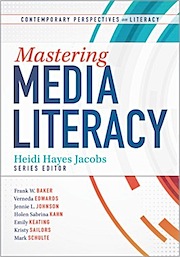
In November 2013, Frank was a co-recipient of the National Telemedia Council‘s annual Jessie McCanse Award given for individual contributions to the field of media literacy over at least 10 years. Follow him on Twitter @fbaker.

